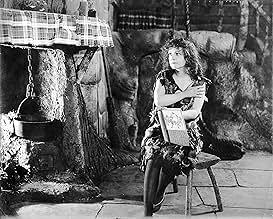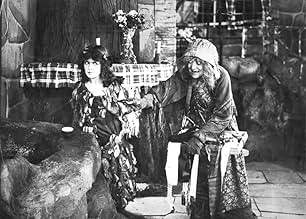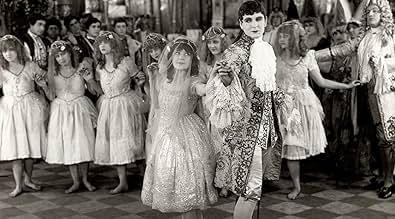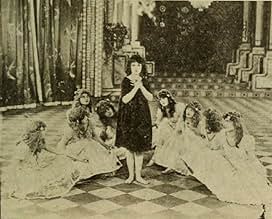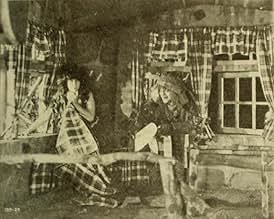Snow White, a beautiful girl, is despised by a wicked queen who tries to destroy her. With the aid of dwarves in the woods, Snow White overcomes the queen.Snow White, a beautiful girl, is despised by a wicked queen who tries to destroy her. With the aid of dwarves in the woods, Snow White overcomes the queen.Snow White, a beautiful girl, is despised by a wicked queen who tries to destroy her. With the aid of dwarves in the woods, Snow White overcomes the queen.
Dorothy Cumming
- Queen Brangomar
- (as Dorothy G. Cumming)
Richard Barthelmess
- Pie Man
- (uncredited)
Arthur Donaldson
- King
- (uncredited)
Irwin Emmer
- Dwarf
- (uncredited)
Billy Platt
- Dwarf
- (uncredited)
Herbert Rice
- Dwarf
- (uncredited)
Jimmy Rosen
- Dwarf
- (uncredited)
Featured reviews
"Snow White", directed in the far away year 1916 by Herr J. Searle Dawley, is a beautiful film adaptation of the classic Grimm fairy tale.This film was considered long lost but fortunately a copy was found in the"Filmmuseum", a kind of Dutch film archives where the nitrates are not very well arranged, certainly nothing like this German aristocrat's film archives where the films are perfectly organized and classified in a German way, so in this way no film is lost, including Herr Stroheim's "Greed" (in its 9 hours complete version
). Anyway, thanks to the good luck of finding this lost silent film, every silent film fan can now appreciate Herr Searle's talent.
"Snow White" ( this German count doesn't think it necessary to relate this well-know story about beauty competitions in the Middle Ages ), as this aristocrat said before, is a visually lovely film in which the art direction and the sets are absolutely outstanding, not to mention the make-up, some charming special effects and even a little animated sequence. As it happens with some remarkable early silent film versions of fairy tales, there is a remarkable concern to depict and recreate in detail the magical atmosphere of those original stories on the screen and this one is a perfect recreation of the tale. It must said though that in those classic film productions, there is not usually a trace of transgression or boldness ( which is scarcely necessary most of the time since the original stories are full of cruelty ),and they are conservative and polite adaptations intended to be harmless and wholesome entertainment for families around the world. "Snow White" starred Dame Marguerite Clark, an important film star in the teens, and she plays her pure and chaste role very well, and the rest of the cast is equally good, all perfect for an early film that doesn't suffer with the passage of time.
And now, if you'll allow me, I must temporarily take my leave because this German Count has an appointment with the evil Queen.
Herr Graf Ferdinand Von Galitzien http://ferdinandvongalitzien.blogspot.com/
"Snow White" ( this German count doesn't think it necessary to relate this well-know story about beauty competitions in the Middle Ages ), as this aristocrat said before, is a visually lovely film in which the art direction and the sets are absolutely outstanding, not to mention the make-up, some charming special effects and even a little animated sequence. As it happens with some remarkable early silent film versions of fairy tales, there is a remarkable concern to depict and recreate in detail the magical atmosphere of those original stories on the screen and this one is a perfect recreation of the tale. It must said though that in those classic film productions, there is not usually a trace of transgression or boldness ( which is scarcely necessary most of the time since the original stories are full of cruelty ),and they are conservative and polite adaptations intended to be harmless and wholesome entertainment for families around the world. "Snow White" starred Dame Marguerite Clark, an important film star in the teens, and she plays her pure and chaste role very well, and the rest of the cast is equally good, all perfect for an early film that doesn't suffer with the passage of time.
And now, if you'll allow me, I must temporarily take my leave because this German Count has an appointment with the evil Queen.
Herr Graf Ferdinand Von Galitzien http://ferdinandvongalitzien.blogspot.com/
Adolph Zukor's company Famous Players in Famous Plays, despite releasing some stagy early feature-length films (e.g. "Queen Elizabeth" (1912) and "The Count of Monte Cristo" (1913)), managed to sign two actresses who become two of the most popular movie stars, Mary Pickford and, the star of "Snow White", Marguerite Clark. Clark had already been a hit on Broadway, including playing the title role in the 1912 theatrical version of "Snow White", for which this film is based. In just her first film, Clark's performance in "Wildflower" (1914) was voted by fans for Motion Picture Magazine the second greatest performance to date by 1916--right above Henry B. Walthall's third place role in "The Birth of a Nation" (1915). As further evidence of her fame, Clark was voted the second most popular movie star in a 1918 Motion Picture Magazine poll, below only Mary Pickford. A Princeton poll in 1919 placed her third among screen actresses. And, she was voted the top female box-office draw by a 1920 Quigley poll.
The filmed "Snow White" is comparable in film technique to another available Famous Plays production, "Cinderella" (1914), which starred Mary Pickford (also to Pickford's "The Taming of the Shrew" (1914), although the print of it that I saw wasn't in the good condition these other two films are in). The camera generally remains stationary as in the earliest feature-length films and mostly from a long-shot framing, but the shot succession is more frequent and better paced in these later films—changing shots based on character movement and with some crosscutting—and there are a few medium shots and closer views, although not nearly enough. "Snow White" seems choppy in parts today, but that's at least partially due to some lost footage.
Although rather stagy even for a 1916 production, "Snow White" is a somewhat enjoyable, light fairytale. As mentioned elsewhere, it borrows from "Cinderella" the part of Snow White forced to do chores by her stepmother. It's also interesting to see Walt Disney's inspiration for his 1937 animated version. The dwarfs are amusing. Additionally, Snow White is friendly with animals in the forests. I don't know how a lion got to a woodland in what one assumes is somewhere in medieval Europe, though. There are a few special effects shots, including the basic superimpositions and substitution-splices for lapse dissolves, as well as a brief animation shot of the witch flying away on her broom, and the miniaturized double exposure of the actors in the introductory tie-in of the film's release with Christmas. Clark does as well as Mary Pickford did; and, unlike the film, she isn't too theatrical. Like Pickford, she was small and often played child and ingénue roles. Unfortunately, most of her films are now unavailable, which makes "Snow White" an even more recommended treat.
The filmed "Snow White" is comparable in film technique to another available Famous Plays production, "Cinderella" (1914), which starred Mary Pickford (also to Pickford's "The Taming of the Shrew" (1914), although the print of it that I saw wasn't in the good condition these other two films are in). The camera generally remains stationary as in the earliest feature-length films and mostly from a long-shot framing, but the shot succession is more frequent and better paced in these later films—changing shots based on character movement and with some crosscutting—and there are a few medium shots and closer views, although not nearly enough. "Snow White" seems choppy in parts today, but that's at least partially due to some lost footage.
Although rather stagy even for a 1916 production, "Snow White" is a somewhat enjoyable, light fairytale. As mentioned elsewhere, it borrows from "Cinderella" the part of Snow White forced to do chores by her stepmother. It's also interesting to see Walt Disney's inspiration for his 1937 animated version. The dwarfs are amusing. Additionally, Snow White is friendly with animals in the forests. I don't know how a lion got to a woodland in what one assumes is somewhere in medieval Europe, though. There are a few special effects shots, including the basic superimpositions and substitution-splices for lapse dissolves, as well as a brief animation shot of the witch flying away on her broom, and the miniaturized double exposure of the actors in the introductory tie-in of the film's release with Christmas. Clark does as well as Mary Pickford did; and, unlike the film, she isn't too theatrical. Like Pickford, she was small and often played child and ingénue roles. Unfortunately, most of her films are now unavailable, which makes "Snow White" an even more recommended treat.
The 1916 SNOW WHITE is undoubtedly one of the most important movies in the history of fantasy pictures. Without it, we would have no Disney SNOW WHITE, and without a Disney SNOW WHITE, the 1939 WIZARD OF OZ would have never been greenlit, along with many other great fantasy films we have enjoyed in the subsequent years. Regardless of this significance, the 1916 SNOW WHITE is not necessarily a classic in its own right,
The positives first though: Marguerite Clark is an exuberant lead, channeling both the princess's innocence and her burgeoning romantic yearning for the prince. The aesthetics of the film are charming in a classic storybook mode, filled with the usual anachronisms you'll find in the world of fairy tales. I also thought the other actors were game with their performances, especially Dorothy Cummings as the vain, scheming queen.
My main issue with this version is the storytelling. So much time is wasted on uninteresting court politics or the Huntsman's cuddly little kids. The dramatic moments lack urgency: when Snow White learns the Huntsman plans to kill her, she basically laughs it off. There is nothing like suspense at all, even as the story builds to its climax. It makes a striking contrast with the Disney adaptation, which, despite its sentimental nature and cheerful songs, undoubtedly had narrative urgency and moments of pure terror that made the happy ending feel earned.
Another problem is the direction, which is flat and static even by 1910s standards. You never really feel transported into another world like you do with, say, Douglas Fairbanks' THE THIEF OF BAGDAD from a few years later. The few moments of interesting staging, such as a close-up of Snow White peeking into the dwarves' cottage through the window (later aped for the Disney movie), throw the overall flatness into even greater relief.
Still, regardless of how this movie plays today, it inspired young Walt Disney to the point where he still treasured the memory of it into his thirties. And for silent film enthusiasts, the survival of this movie is still a great blessing, not just because of the film's historical significance, but because it gives us a glimpse of the otherwise elusive Marguerite Clark, who has so little work surviving.
The positives first though: Marguerite Clark is an exuberant lead, channeling both the princess's innocence and her burgeoning romantic yearning for the prince. The aesthetics of the film are charming in a classic storybook mode, filled with the usual anachronisms you'll find in the world of fairy tales. I also thought the other actors were game with their performances, especially Dorothy Cummings as the vain, scheming queen.
My main issue with this version is the storytelling. So much time is wasted on uninteresting court politics or the Huntsman's cuddly little kids. The dramatic moments lack urgency: when Snow White learns the Huntsman plans to kill her, she basically laughs it off. There is nothing like suspense at all, even as the story builds to its climax. It makes a striking contrast with the Disney adaptation, which, despite its sentimental nature and cheerful songs, undoubtedly had narrative urgency and moments of pure terror that made the happy ending feel earned.
Another problem is the direction, which is flat and static even by 1910s standards. You never really feel transported into another world like you do with, say, Douglas Fairbanks' THE THIEF OF BAGDAD from a few years later. The few moments of interesting staging, such as a close-up of Snow White peeking into the dwarves' cottage through the window (later aped for the Disney movie), throw the overall flatness into even greater relief.
Still, regardless of how this movie plays today, it inspired young Walt Disney to the point where he still treasured the memory of it into his thirties. And for silent film enthusiasts, the survival of this movie is still a great blessing, not just because of the film's historical significance, but because it gives us a glimpse of the otherwise elusive Marguerite Clark, who has so little work surviving.
Supposedly this what got Disney's mind oriented toward cartoon versions of well known "fairy tales."
But we can hardly blame it for the patronizing travesty he has performed on children's literature. The story here is a bit Bolwderized (some sex, and much cruelty have been removed from the traditional version). But it is still complex and has lots of side stories, like how she disguises herself as one of her maids in waiting. And how the stepmother tried a comb first, before the apple.
The structure of the play on which this is based is supposedly influenced by the revival of Macbeth then current in London, where the Shakespeare story is explained as controlled by the three witches. Here it is almost as if the witch were responsible for the Faustian deal the ugly stepmother makes.
This film was conceived as a direct result of the amazing popularity of "Birth of a Nation," perhaps the most influential film in history. That's because Birth cemented the notion that movies are like plays not an entirely predetermined outcome. This was the first big budget play to be movie-ized afterward.
The film is in bad condition, so you have to imagine which cuts were original and which are because of missing segments. I prefer to imagine most of the jumps as missing material because the thing moves so languorously in what we see. For instance, there's a clearly drawn Queen's Toady who we spend many minutes watching in pompous walk.
Ted's Evaluation -- 2 of 3: Has some interesting elements.
But we can hardly blame it for the patronizing travesty he has performed on children's literature. The story here is a bit Bolwderized (some sex, and much cruelty have been removed from the traditional version). But it is still complex and has lots of side stories, like how she disguises herself as one of her maids in waiting. And how the stepmother tried a comb first, before the apple.
The structure of the play on which this is based is supposedly influenced by the revival of Macbeth then current in London, where the Shakespeare story is explained as controlled by the three witches. Here it is almost as if the witch were responsible for the Faustian deal the ugly stepmother makes.
This film was conceived as a direct result of the amazing popularity of "Birth of a Nation," perhaps the most influential film in history. That's because Birth cemented the notion that movies are like plays not an entirely predetermined outcome. This was the first big budget play to be movie-ized afterward.
The film is in bad condition, so you have to imagine which cuts were original and which are because of missing segments. I prefer to imagine most of the jumps as missing material because the thing moves so languorously in what we see. For instance, there's a clearly drawn Queen's Toady who we spend many minutes watching in pompous walk.
Ted's Evaluation -- 2 of 3: Has some interesting elements.
Adapted by Winthrop Ames from his own 1912 Broadway adaptation of the tale published exactly a hundred years earlier by the Brothers Grimm, 'Snow White' was one of Adolph Zukor's Famous Players productions, the Famous Player on this occasion being Marguerite Clark in the role she had created on stage. Aged 33 when the film version was made but easily passing for a girl half her real age, Miss Clark is surrounded by a handsome if stagy production, lushly photographed by H. Lyman Broening, who when called upon also conjures up more spooky visuals for scenes such as down in the dwarfs' mine and - most vividly - the witch's lair; both of which can be recognised in the 1937 version produced by Walt Disney, who saw this as a 15 year-old. In this version, the witch and the wicked stepmother are separate characters; the former played for laughs by Alice Washburn, with Dorothy Cumming as the latter resembling Ellen Terry as Lady Macbeth in John Singer Sargent's famous 1889 portrait.
Did you know
- TriviaThe first movie Walt Disney ever saw.
- GoofsA crew member's shadow is visible on the ground in front of Snow White after Berthold the Huntsman leaves her in the forest.
- Alternate versionsOriginal release prints contained, according to a review by Variety, a sequence in which a stork delivers the infant Snow White to her mother, is not in the Treasures from American Film Archives print.
- ConnectionsFeatured in The Walt Disney Story (1973)
- How long is Snow White?Powered by Alexa
Details
- Runtime
- 1h 3m(63 min)
- Color
- Sound mix
- Aspect ratio
- 1.33 : 1
Contribute to this page
Suggest an edit or add missing content

